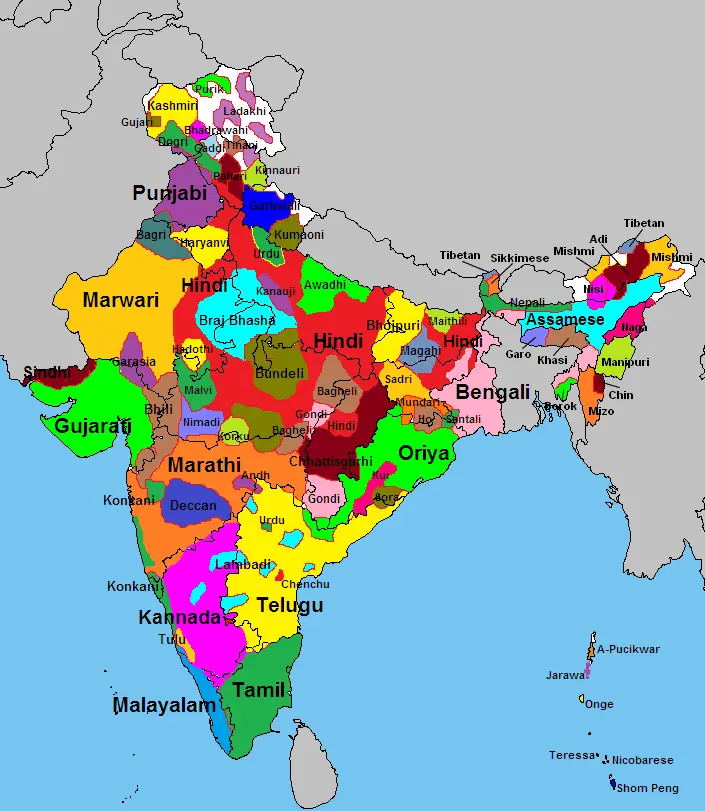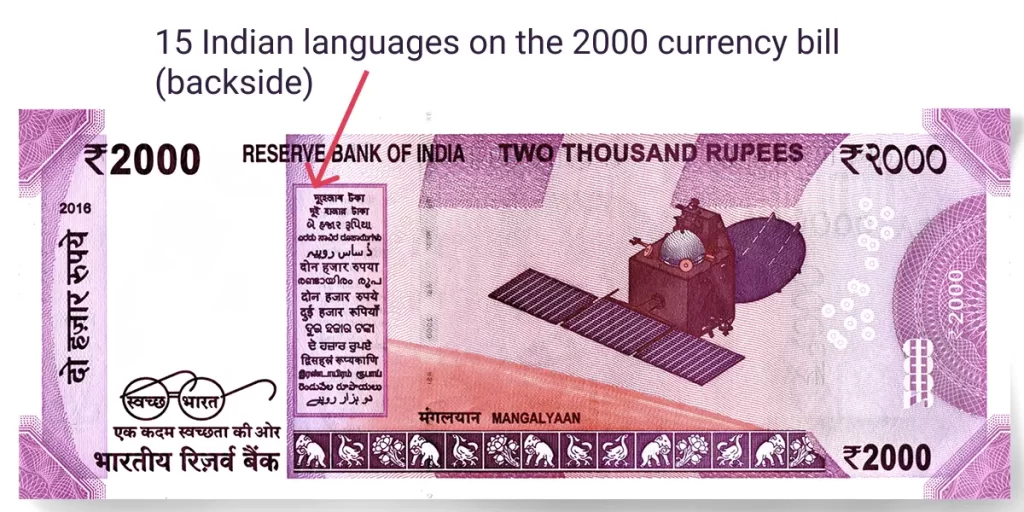Like Indian cultures, the languages of India are rich, ancient, and diverse. India is a blend of various beliefs, cultures and religions and it has an uncountable lingual family. The term “subcontinent” is widely used to refer India, Pakistan, Sri Lanka, and Bangladesh, as India is a country that contains many countries.
As the evolution of dialects and languages is dynamic, influenced by socio eco-political developments, around 22 languages of India have been recognised as Scheduled languages in the Schedule VIII of the Indian Constitution. Each Indian state also happens to be pluricultural, besides showing a great degree of multilingualism.
Read also: Oldest languages of India

India has always been a knowledge super-power, producing both knowledge that has universal relevance as well as the knowledge that needs to be differentiated by cultural specificity that makes it useful for the Indian society. This vast expanse in the domain of knowledge production did not come from the introduction of western education in the country, as cultural contacts with other civilizations have happened here for many many centuries.
22 Scheduled Languages of India
The Census of India has classified languages in the categories of Scheduled and Non-Scheduled languages. There are 22 Scheduled and 100 Non-Scheduled languages. As of today, the Indian constitution recognizes 22 major languages of India in what is known as “the 8th Schedule” of the Constitution. They also happen to be the major literary languages in India, with a considerable volume of writing in them.
| Rank | Language | Persons speaking as mother tongue | % to total population |
|---|---|---|---|
| 1 | Hindi | 52,83,47,193 | 43.63 |
| 2 | Bengali | 9,72,37,669 | 8.03 |
| 3 | Marathi | 8,30,26,680 | 6.86 |
| 4 | Telugu | 8,11,27,740 | 6.70 |
| 5 | Tamil | 6,90,26,881 | 5.70 |
| 6 | Gujarati | 5,54,92,554 | 4.58 |
| 7 | Urdu | 5,07,72,631 | 4.19 |
| 8 | Kannada | 4,37,06,512 | 3.61 |
| 9 | Odia | 3,75,21,324 | 3.10 |
| 10 | Malayalam | 3,48,38,819 | 2.88 |
| 11 | Punjabi | 3,31,24,726 | 2.74 |
| 12 | Assamese | 1,53,11,351 | 1.26 |
| 13 | Maithili | 1,35,83,464 | 1.12 |
| 14 | Santali | 73,68,192 | 0.61 |
| 15 | Kashmiri | 67,97,587 | 0.56 |
| 16 | Nepali | 29,26,168 | 0.24 |
| 17 | Sindhi | 27,72,264 | 0.23 |
| 18 | Dogri | 25,96,767 | 0.21 |
| 19 | Konkani | 22,56,502 | 0.19 |
| 20 | Manipuri | 17,61,079 | 0.15 |
| 21 | Bodo | 14,82,929 | 0.12 |
| 22 | Sanskrit | 24,821 | negligible |
Of these Indian languages, 14 were initially included in the Constitution. Sindhi language was added in 1967. Thereafter three more languages viz., Konkani, Manipuri and Nepali were included in 1992. Subsequently Bodo, Dogri, Maithili and Santhali were added in 2004.
The first Prime Minister of India, Pt. Jawaharlal Nehru had made this comment about the recognition of languages: ‘The makers of our Constitution were wise in laying down that all the 13 or 14 languages were to be national languages. There is no question of anyone’s language being more a national language than the others… (Kumaramangalam 1965).
Hindi (in Devanagari script) and English are the two official languages of India. India does not have a single national language.
Indian Language Families
It is estimated that there have been great movements of Indian people and races that made it possible for India to be the home for so many ethnic groups. The expansions of EuropeAid people (probably Tocharians) possibly started around 3800 years ago.
And, perhaps 1000 years (or more) earlier, Indo-European speakers from the oases south of the Urals, north of the Black Sea, and in western Kazakstan moved in western and in eastern directions, and finally moved to the south, mixing with (presumably) Dravidian or the other original inhabitants of the South Asian region.
Indian languages are huge in number, so, they have been broadly divided into four families.
Indo – European Family (Arya)
The former Indo- European Family is numerically and culturally considered the most important family in India. About 73% of the entire Indian population speaks different languages of the Aryan Family. They are further divided as the Dardic Aryan Languages and the Indo Aryan Languages
The Dardic Aryan Languages
This group contains variety of languages that are current among tiny mountain communities in Jammu and Kashmir. Small communities living on the boundary between Afghanistan and Pakistan also speak the language. They fall into three categories – Shina with Kashmiri, Kohistani and Shina proper ; Khowar or Chitrali or Chatran and Nuristani dialects.
The Indo-Aryan Languages
This subgroup includes languages like Hindi, Rajasthani, Gujarati, Bengali, Punjabi, Marathi, Sindhi, Kachchi, Oriya, Assamese, Sanskrit, and Urdu. They are grouped based on the regional distribution of the people.
Northern Aryan Languages Spoken by hilly people in North India. They consist of languages like Nepali, Central Pahari and Western Pahari.
Northern – Western Aryan Languages They speak Khanda, Kachchi and Sindhi
Southern Aryan Languages Marathi and Konkani are included in the Southern group of Aryan languages.

Eastern Aryan Languages Bihari, Oriya, Bengali and Assamese languages constitute this group of Eastern parts of the country.
East Central Aryan Languages Avadhi, Bugheli and Chhattisgarhi are included here for the regions like Avadh, Bundelkhand and Chhattisgarh.
Central Aryan Languages The main languages of this region are Hindi, Rajasthani, Punjabi, and Alawari. Out of which Hindi is the most important language because it is largely spoken.
Dravidian Languages
About 20 percent of the Indian population speak the Dravidian Languages.
Dravidian languages are older than the Aryan languages. They fall into two main groups. The southern (Dravidian) languages of India were less impacted by the Mughal invasion.
The North Dravidian Languages
Telugu, Gondi dialects, Kuruth or Oraon, Maler or Malpahariya, Kui or Kandh, Parji, Kolami, and a few others are included in this group. Telugu is the most important of all the Dravidian languages because it has very rich in literature and also spreads outside India (Myanmar, Indo-China, and South Africa). Its vocabulary is much influenced by Sanskrit.
- Telugu is also known as “Italian of the East” (Read more about Languages of Italy)
South Dravidian Languages
This group of languages includes Tamil, Malayalam, and Kannada. A number of speeches like Tulu, Kurgi, Kota, and Toda are also included in this group. Tamil is mostly spoken in larger parts of Tamil Nadu. Outside India, it is spoken as an official language in Sri Lanka. Malayalam is currently the language of Kerala and Lakshadweep. The literary cultivation of the Kannada language began from the middle of the first millennium A.D
- Malayalam, the language of the southern Indian state of Kerala, is the longest palindrome in the English language.
Austric Languages
The Austric languages are sub-divided into Munda and Mon-Khmer. Munda languages are an immense of the Austric group of languages. They consist of fourteen tribal languages. Santhali, Mundari, and Ho languages have pleasant literature comprising of songs and fictitious romantic stories. Mon-Khmer languages include Khasi spoken by Meghalayans and Nicobari spoke by people from Nicobar Islands.
The Munda languages in India are spoken in the eastern and southern parts of India. The well-known Munda languages include the following: Santali, Mundri, Bhumij, Bihar, Ho, Tri, Korku, Khari, Juang, Savara, etc. The Munda speakers are found mostly in the hills and jungles, while the plains and valleys have some pockets inhabited by people speaking these indigenous languages of India.
Sino-Tibetan languages
It has three major divisions – The Tibeto-Himalayan – Himalayan group and the Bhutia group. It is further sub-divided as the Himalayan group and the Bhutia group. The Himalayan group consists of 4 languages – Chamba, Lahauli, Kannauri and Lepcha. Ladakhi has the huge number of Bhutia speakers.
Lepcha, Sikkimese, Garo, Bodo, Manipuri, and Naga are some of the better-known Tibeto-Burman languages. Besides a few that are close to Tibetan, the South Himalayan languages spoken from Lahul in the west (Himachal Pradesh) to Bhutan in the east are quite distinct.
Bodo and Tipra sub-groups are now well-known, and so are the Naga languages.
Conclusion: Languages of India
Language has become a very important basis for the formation of Indian states adding a unique meaning to the geographical expansion of languages. However, the languages and dialects vary from north-eastern, eastern and central parts of the country based on the population of people who live in unspecified areas or regions.
Given the effects of globalization on languages, Indians are being influenced by western languages, in particular English. On the other hand, the central and state governments are putting tremendous efforts to promote the local/regional languages.
To summarize, Kashmiri, Punjabi, Hindi, Bengali, Assamese, Gujarati, Marathi, Kannada, Tamil, Telugu, Malayalam, Oriya are considered to be the twelve most widely spoken languages of India among the diversified culture.
Read also How Many Languages In The World.